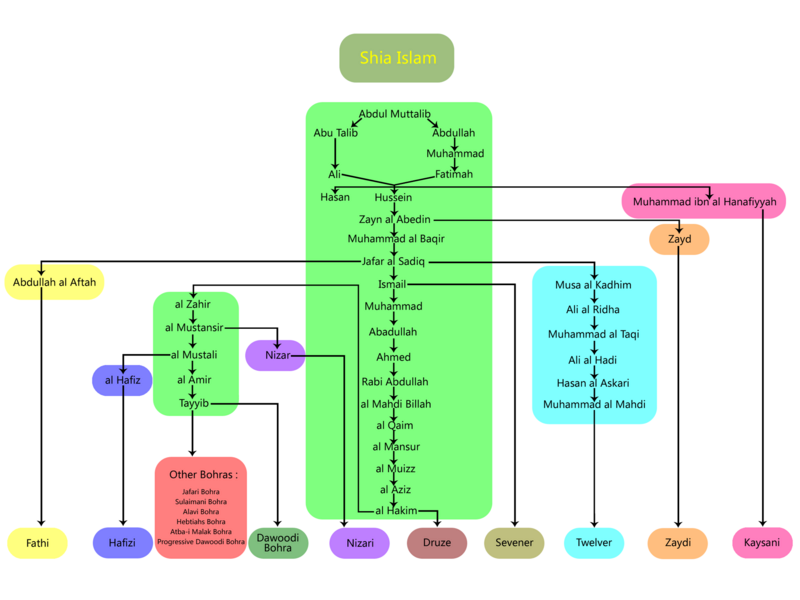الإسماعيلية الطَيِّبية
| جزء من سلسلة عن الإسلام الشيعي
الإسماعيلية |
|---|
 |
|
|
الإسماعيلية الطيِّبية هي الطائفة الوحيدة المتبقية من الفرع المستعلي في الإسماعيلية، the other being the extinct Hafizi branch. أتباع الإسماعيلية الطيبية يتواجدون في مختلف تجمعات البهرة: الداودية وSulaymani، و العلوية.
The Tayyibi originally split from the Fatimid Caliphate-supporting Hafizi branch by supporting the right of الطيب أبو القاسم to the Imamate.
التاريخ
بوفاة الإمام العشرين، الآمر بأحكام الله (ت. هـ 526 (1131/1132)), his two-year-old child الطيب أبو القاسم (و. هـ 524 (1129/1130)) was appointed the twenty-first Imam. As he was not in a position to run the Dawah، الملكة أروى الصليحي، his Hujjah, established the office of the Da'i al-Mutlaq, who acted as his sword. The Da'i had now been given absolute authority and made independent from political activity.
الداعي ذئيب بن موسى
الداعي ذئيب بن موسى used to live in and died in Hoos، اليمن. His ma'zoon ("associate") was Khattab bin Hasan. After death of عبد الله, ذئيب بن موسى عَيَّن يعقوب as the wali ("representative" or "caretaker") of the Tayyibi organization ("dawah") in India. Yaqub was the first person of Indian origin to receive this honor. He was son of Bharmal, minister of the Chaulukya king Jayasimha Siddharaja. فخر الدين، ابن طرمل، أُرسِل إلى غرب راجستان. One Da'i after another continued حتى الداعي الرابع والعشرين، يوسف نجم الدين بن سليمان، في اليمن. Due to prosecution by a local ruler, the dawah then shifted to India تحت الداعي الخامس والعشرين، جلال بن حسن.
الانشقاق السليماني-الداوودي-العلوي
في 1592، the Tayyibi broke into two factions in a dispute over who should become the twenty-seventh Da'i: داوود بن قطب شاه أو Sulayman bin Hassan. The followers of the former, primarily in India, became the Dawoodi Bohra, the latter the Sulaymani of Yemen. In 1621, the Alavi Bohra split from the Dawoodi bohra community.
There is also a community of Sunni Bohra in India. In the fifteenth century, there was schism in the Bohra community of Patan in Gujarat as a large number converted from Mustaali Ismaili Shia Islam to mainstream Hanafi Sunni Islam. The leader of this conversion movement to Sunni was Syed Jafar Ahmad Shirazi who also had the support of Mughal governor of Gujarat. Thus this new group is known as Jafari Bohras, Patani Bohras or Sunni Bohra. In 1538, Syed Jafar Ahmad Shirazi convinced the Patani Bohras to cease social relations with Ismaili Bohras. The cumulative results of these pressures resulted in large number of Bohras converting from Ismaili Shia fiqh to Sunni Hanafi fiqh.
The Hebtiahs Bohra was a branch of Mustaali Ismaili Shi'a Islam that broke off from the mainstream Dawoodi Bohra after the death of the 39th Da'i al-Mutlaq in 1754. The Atba-e-Malak community are a branch of Mustaali Ismaili Shi'a Islam that broke off from the mainstream Dawoodi Bohra after the death of the 46th Da'i al-Mutlaq, under the leadership of Abdul Hussain Jivaji in 1840. They have further split into two more branches, the Atba-e-Malak Badar and Atba-e-Malak Vakil. The Progressive Dawoodi Bohra is a reformist sect within Mustaali Ismai'li Shi'a Islam that broke off circa 1977. They disagree with mainstream Dawoodi Bohra, as led by the Da'i al-Mutlaq, on doctrinal, economic and social issues.
At present, the largest Tayyibi faction/sub-sect is the Dawoodi Bohra, whose current leader is Syedna المفضل سيف الدين. Taher Fakhruddin is also a claimant to the title of Dai al Mutlaq since 2016, although it is widely accepted that Syedna Mufaddal Saifuddin is the leader of the Dawoodi Bohras, in all aspects and administration.

المراجع
- The Ismaili, their history and doctrine by Farhad Daftary
- Religion, learning and science by Lathan Young
- Medieval Islamic Civilisation by Joseph W. Meri, Bacharach
- Sayyida Hurra: The Isma‘ili Sulayhid Queen of Yemenby Farhad Daftary
- The Uyun al-akhbar is the most complete text written by an Ismaili/Tayyibi/Dawoodi 19th Dai Sayyedna Idris bin Hasan on the history of the Ismaili community from its origins up to the 12th century CE. period of the Fatimid caliphs al-Mustansir (d. 487 AH / 1094 AD), the time of Musta‘lian rulers including al-Musta‘li (d. 495 AH / 1102 AD) and al-Amir (d. 526 AH / 1132 AD), and then the Tayyibi Ismaili community in Yemen.